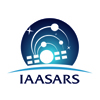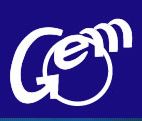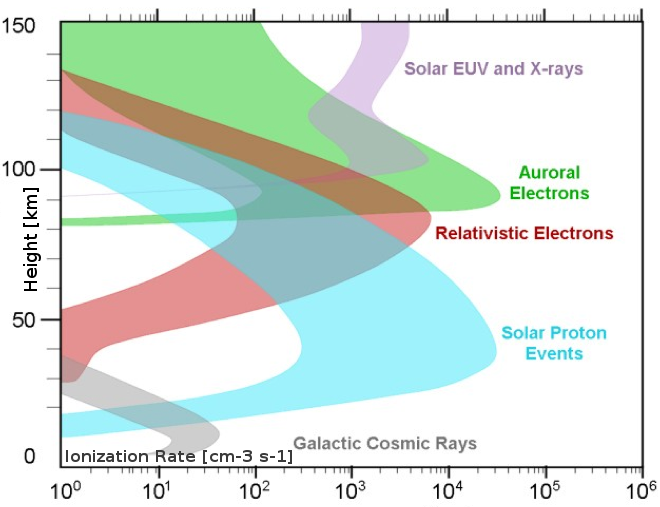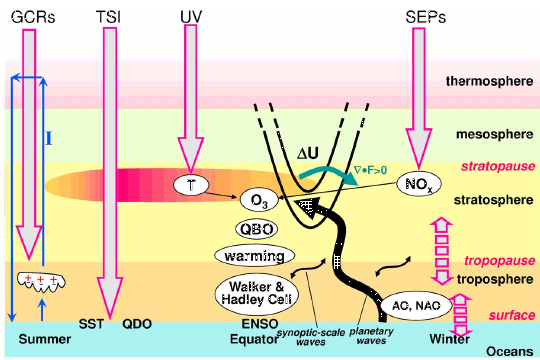
Meetings related to VarSITI in 2015
Meetings related to VarSITI in 2015
The 3rd AOSWA Workshop and 2015 UN/Japan Workshop on Space Weather
March 2-5, 2015, Fukuoka, Japan Workshops completed successfully
AOSWA Workshop web-address http://aoswa.nict.go.jp/workshop_3/index.html
UN/Japan Workshop web-address http://www.unoosa.org/oosa/en/SAP/act2015/japan/index.html
The Role of the earth and its atmosphere on our technology
(2nd annual conference of Nigerian Geophysical Society)
17-20 March, 2015, Covenant University, Ogun State, Nigeria supported by SCOSTEP Look at report
web-address www.niggs.org/index.php/conference
Inner Magnetosphere Coupling III (IMC III)
March 23-27, 2015 Los Angeles, CA, USA Conference completed successfully
web-address http://www.i-mp.org/conference/i-mp_2015/
EGU General Assembly 2015 April 12-17, 2015, Vienna, Austria EGU General Assembly completed successfully
Session Title: Solar-Terrestrial SciencesSession ID: ST1.4, Title: Preconditioning of interplanetary space - a Space Weather parameter
Session ID: ST2.4, Title: Radiation Belts: The balance of energization and loss processes
web-address http://www.egu2015.eu/home.html
Conference on Superflares and Activity of the Sun in the Cycle Formation Epoch
28 April-1 May 2015 Katsrin & Tel Aviv Israel supported by SEE/VarSITI Look at report
web-address HERE
2015 African Geophysical Society Conference 1–5 June 2015 Nairobi Kenya supported by VarSITI
Conference completed successfully Read more
web-address http://www.afgps.org
26th General Assembly of the International Union of Geodesy and Geophysics (IUGG) 2015
June 22-July 2, 2015, Prague, Czech Republic
web-address http://www.iugg2015prague.com/
Symposium A15: “Long-term trends in the stratosphere, mesosphere, thermosphere, and ionosphere” supported by ROSMIC read more Look at report
Symposium A16: “Energetic Particle Precipitation into the Atmosphere: Sources and Atmospheric Impacts” supported by SPeCIMEN & ROSMIC read more Look at report
Asia Osceania Geosciences Society (AOGS) 12th Annual Meeting August 2-7, 2015, Singapore
web-address http://www.asiaoceania.org/society/index.asp
Session ID: ST24, Title: Solar activity, Space Weather and Space Climate in SCOSTEP's VarSITI program Read more
Session ID: ST 30 Title:The Strange State of the Heliosphere during the Weak Solar Cycles 24 and its Implications Read more
International School on Equatorial and Low-Latitud Ionosphere, ISELLI
14-18 September 2015 Abuja, Nigeria supported by VarSITI
SCOSTEP-WDS Workshop- “Global Data Activities for the Study of Solar-Terrestrial Variability” 28-30 September 2015 Tokyo Japan supported by VarSITI
Workshop completed successfully Read more
web-address http://isds.nict.go.jp/scostep-wds.2015.org/
Coimbra Solar Physics Meeting "Ground-based Solar Observation in the Space Instrumentation Era" 5-9 October 2015, Coimbra Portugal supported by VarSITI
web-address http://www.mat.uc.pt/~cspm2015/overview.html
14th International Symposium on Equatorial Aeronomy October 19-23, 2015, Bahir Dar, Ethiopia
supported by VarSITI
web-address http://www.bdu.edu.et/isea14/
2015 AGU Fall meeting, 14-18 December 2015, San Francisco, USA
web-address http://fallmeeting.agu.org/2015/
Session ID: 8286 Title: NH030: Space Weather Hazards of Perturbed Ionospheric Currents: Monitoring and Early Warning. Read more
Session ID: 8763: The Physics of Small-scale Magnetic Flux Ropes Throughout the Heliosphere
Read more
Meetings related to SEE/VarSITI in 2015
Solar Variability and its Heliospheric Effects
2-6 November 2015 Athens Greece
supported by VarSITI
web-address: http://bbc-sws.astro.noa.gr
The main goal of this conference is to bring together experts in different areas of Solar-Terrestrial Research, in order to obtain a comprehensive picture of the chain of events originating from the Sun affecting the Heliosphere and the Earth’s environment and climate. The conference will include several dedicated sessions covering aspects on the Sun and solar activity, theoretical modeling and observations of solar eruptive events, the solar wind and the heliosphere, solar drivers of geomagnetic disturbances, magnetospheric and ionospheric research advances, solar influences on the middle and lower atmosphere as well as the climate, space weather data and services etc
The Venue is the conference facility of the Museum of the History of the University of Athens, right in the center of the Plaka area, in the nice archaeological site around the Acropolis, the ancient Agora where the ancient philosophers used to develop their philosophy for life and existence and the origin of the world.
The address of the Athens University History Museum is: Tholou Str, 5, Plaka, P.C. 105 56, Athens Greece.
Look for with Google maps
Organisers and Sponsors
 Institute for Astronomy, Astrophysics,
Institute for Astronomy, Astrophysics,Space Applications and Remote Sensing
(IAASARS)
National Observatory of Athens
Metaxa & Vas. Pavlou str.
15236 Penteli, Athens, GREECE
Tel:+30-210-8109109, +30-6944369713
Fax:+30-210-6138343
Email: omaland[at]noa.gr

Variability of the Sun and Its Terrestrial Impact
- Olga Malandraki (IAASARS) - Chair
- Georgia Tsiropoula (IAASARS)
- Kostas Tziotziou (IAASARS)
- Alexandra Maragoudaki (IAASARS) - Secretary
Meetings related to ISEST/MiniMax24/VarSITI in 2015
International Study of Earth-affecting Solar Transients
(ISEST/MiniMax24) Workshop
26-30 October 2015, National Autonomous University, Mexico City, Mexico
supported by VarSITI
web-address: http://cintli.geofisica.unam.mx/congreso/
First Announcement 15 April (here)
Second Announcement 15 July (here)
Fourth Announcement 19 October (here)
About the workshop
The International Study of Earth-Affecting Solar Transients (ISEST)/MiniMax Workshop is aimed at bringing together scientists from different countries to interact and establish collaboration links that can effectively address the physical mechanisms of the origin, propagation, and Earth impact of coronal mass ejections (CMEs) and other transient events. The ultimate goal is to develop the capability to predict the arrival of solar transients at Earth and their potential Space Weather consequences. ISEST/MiniMax is one of the four projects of SCOSTEP’s VarSITI program (2014-2018). The workshop coordinates international activity in observation, theory and modeling, and involves scientists from both developed and developing countries. The workshop also provides an online platform for research and educational opportunities for students. The workshop will have sessions relevant to the seven ISEST/MiniMax working groups: (1) data, (2) theory, (3) simulation, (4) event campaign, (5) Bs challenge, (6) Solar Energetic Particles, and (7) MiniMax campaign.
If you are interested in attending this workshop in Mexico City, please register for participation (here) by August 10, 2015 August 17, 2015.
Note from Jie Zhang: Due to a hardware failure, the meeting website went down for three days, right around the registration deadline. We apologize for any inconvenience and confusion thus caused.
The registration deadline is now postponed by one week, to August 17, 2015. Please visit http://cintli.geofisica.unam.mx/congreso and register ASAP.
You are also welcome to participate online through ISEST Main_Page.
A limited financial support is available to graduate students and young researchers. This support comprises only the local hotel cost and the registration fee. Please send an email along with your CV and tentative abstract to Alejandro Lara (alara.unam[at]gmail.com) before August 01, 2015 to apply for this financial support.
Organisers and Sponsors

Variability of the Sun and Its Terrestrial Impact
Jie Zhang (Co-Chair, USA), Nat Gopalswamy (Co-Chair, USA), Manuela Temmer (Co-Chair, Austria), Ayumi Asai (Japan),
Mario Bisi (UK), Kyungsuk Cho (South Korea),
Peter Gallagher (Ireland), Manolis Georgoulis (Greece),
Alejandro Lara (Mexico), Noé Lugaz (USA),
Alexis Rouillard (France), Nandita Srivastava (India),
Bojan Vrsnak (Croatia), Yu-Ming Wang (China),
David Webb (USA) and Yuri Yermolaev (Russia)
Alejandro Lara (Chair), Xochitl Blanco-Cano, Rogelio Caballero, Olivia Enríquez, Alberto Flandes, Primoz Kajdič and Hector Pérez de Tejada
Meetings related to SPeCIMEN/VarSITI in 2015
session at the workshop
"Plasma Physics in Solar System"
16-20 February 2015, Moscow, Russia The workshop completed successfully
Working language is Russian
web-address: http://plasma2015.cosmos.ru/
Ses: Low frequency wave processes in space plasmas
Ses: Quantitative Assessment of Radiation Belt Modeling
Inner Magnetosphere Coupling III (IMC III)
23-27 March 2015, Los Angeles, California, USA Conference completed successfully
web-address:http://www.i-mp.org/conference/i-mp_2015/
Read more about this workshop from our site
Geospace Environment Modeling (GEM) workshop
15-19 June 2015, Snowmass, Colorado, USA
focus group Quantitative Assessment of Radiation Belt Modeling
web-address: http://aten.igpp.ucla.edu/gemwiki/index.php/Main_Page

The Geospace Environment Modeling (GEM) program is a National Science Foundation (NSF) Division of Atmospheric Sciences initiative to coordinate and focus research on the near-earth portion of geospace from the lower ionosphere to where the earth system interacts with the solar wind. The purpose of GEM program is to support basic research into the dynamical and structural properties of geospace, leading to the construction of a global geospace general circulation model (GGCM) with predictive capability. The GGCM effort is now being treated as a separate campaign. The strategy for achieving GEM goals is to undertake a series of campaigns, in both theory and observational modes, each focusing on particular aspects of the geospace environment.
focus group Quantitative Assessment of Radiation Belt Modeling:
Topic Description Understanding the dynamics of energetic particles in Earth’s radiation belts is of interest both scientifically and practically. Over the past few decades, various physical processes have been identified as potential mechanisms for the acceleration, transport, and loss of radiation belt particles. These processes, which have been mainly developed separately in the past, are now mature enough to be combined and assessed as a whole in accounting for the observed radiation belt dynamics. Furthermore, this assessment can now be performed quantitatively, owing to the unprecedented high-quality wave and particle measurements in radiation belts from multiple spacecraft, and the greatly enhanced fidelity in radiation belt modeling. Motivated by these facts, this new Focus Group (FG) on “Quantitative Assessment of Radiation Belt Modeling” will bring together the current state-of-art models for the acceleration, transport, and loss processes in radiation belts, develop event-specific and global wave, plasma, and magnetic field models to drive these radiation belt models, and finally combine all these components to achieve a quantitative assessment of the relative importance of acceleration, transport, and loss processes in radiation belts by validating against contemporary radiation belt measurements.
session at the
26th General Assembly of the International Union of Geodesy and Geophysics (IUGG) 2015
22 June - 2 July 2015, Prague, Czech Republic
web-address:http://www.iugg2015prague.com/
Read more about 26th General Assembly of IUGG from our site
A16 Energetic Particle Precipitation into the Atmosphere: Sources and Atmospheric Impacts
A17 The Earth’s Plasmasphere: Remote Sensing and Modelling (Div. II-VERSIM)
A18 Sun-Earth System Response to Extreme Solar Events and Space Weather (Div. II/Div. III)
A19 ULF Waves: Space-Ground Coordination (Div. III)
A20 ULF waves in the inner magnetosphere (Div. III)
A21 Wave and Particle Dynamics in the Radiation Belts and Ring Current (Div. III)
A23 Different Response Modes of the Magnetosphere to Solar Wind Driving (Div. III)
A24 The Plasmasheet - Ionosphere, a Coupled System: Sinks, Sources, Transport and the Roles of Field-Aligned Currents and Ion Outflow (Div. III/Div. II)
A27 Reporter Review for Div III
Unsolved problems of magnetospheric physics supported by SPeCIMEN
6-11 September 2016, Scarborough, UK
web-address:http://spacescience.org/upmpw/
Registration Fee (after 6th June 2015) : £380
Guests (icebreaker, banquet, excursions) : £120
The workshop will be limited to a maximum of
55 people. Please register early to confirm your place. Please complete the registration form and email to Mick Denton: Email Link
Workshop Structure: The workshop will take the form of morning and evening sessions with ample time for both formal talks and workshop-style discussion. Afternoons will be left largely to informal discussion and leisure.
Workshop Topics: The workshop will focus on unresolved problems in magnetospheric physics. Example discussion topics are detailed on workshop web-site (http://spacescience.org/upmpw/)
Organising Committee:
Joe Borovsky (Space Science Institute, USA);
Mick Denton (Space Science Institute, USA); Marina Stepanova (Universidad de Santiago de Chile; Chile);
Joanna Denton (UK);
James Denton (UK)
Meetings related to ROSMIC/VarSITI in 2015
Conference on Sun-Climate Connections
16-19 March 2015 Kiel Germany
Workshop completed successfully
web-address: http://scc.geomar.de/
A printable (pdf, two pages) version of the program ![]()
Please follow the link to see the full program including abstracts.
Session 3: Effects of Energetic Particles on Earth's Atmosphere and Climate supported by ROSMIC

This session focuses on observations of the complex interaction of energetic particles with the atmosphere, at different altitudes and on varying time-scales. We seek contributions on Cosmic rays, Solar Energetic Protons and other types of particles that affect physical and chemical atmospheric processes, which feed-back into the climate system.

Session 4: Modeling studies of solar influences on climate supported by ROSMIC
Numerical modeling of the impacts of solar variability on the climate system from the upper atmosphere to the oceans can help in better understanding processes involved in producing these impacts. For this session we seek contributions presenting such studies covering solar forcing of all types and timescales and numerical tools ranging from simple conceptual to complex Earth system models. We particularly welcome studies dealing with coupling processes in the climate system. We also encourage contributors to discuss experience with model intercomparison studies and what will be needed to make future intercomparison projects useful for solar-climate research.
International Symposium on Arctic Research-4 (ISAR-4)
April 27-30, 2015 Toyama Japan
web-address: http://isar-4.jp/

